

How to Create an Inviting Virtual K-12 Math Classroom. As math coaches, we’ve worked for months now with teachers who are striving to create lively, inviting virtual classrooms.
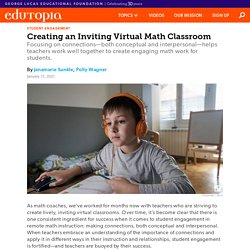
Over time, it’s become clear that there is one consistent ingredient for success when it comes to student engagement in remote math instruction: making connections, both conceptual and interpersonal. When teachers embrace an understanding of the importance of connections and apply it in different ways in their instruction and relationships, student engagement is fortified—and teachers are buoyed by their success. Consider Visibility Whether you are in a school building or teaching remotely, student thinking—including connections they make among ideas—needs to inform your teaching decisions; collecting student thinking and making it visible informs teachers’ planning for the next day’s lesson.
Jamboard, Classkick, Padlet, Pear Deck, and Nearpod are all platforms that both promote student engagement and capture student thinking. Engaging Students in Math. Often, that starts with us as teachers. Developing an environment where students can experiment and gain entry into the language of math starts with having a person who can facilitate what Stephen Krashen termed a low affective filter environment. Twitter. “Who’s Doing the Work?” Classroom Strategies. Twitter. Pacing Lessons for Optimal Learning. The 100 Number Task - during a Pandemic (Is it possible?) - Sara VanDerWerf. The Number One most viewed post (by a factor or 8 or 10) at my website is the 100 NUMBER TASK – for building group work norms.
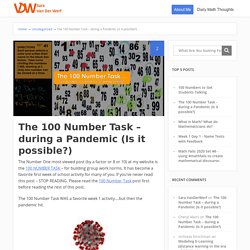
It has become a favorite first week of school activity for many of you. If you’ve never read this post – STOP READING. Please read the 100 Number Task post first before reading the rest of this post. The 100 Number Task WAS a favorite week 1 activity….but then the pandemic hit. Our world was turned upside down. 100 Numbers to Get Students Talking - Sara VanDerWerf. UPDATE AUGUST 2020: Is it possible to do the 100 Number Task in Distance Learning?

I have a new post answering this question. Check it out HERE UPDATE May 2020 – Several super creative educators are re-imagining this activity for the COVID-19 era. Scroll to the bottom for links to their ideas. 30 Ways to Make Math FUN for Elementary Kids - Mr Elementary Math. New video of @BerkeleyEverett sharing one of his major mathematics influences #RXMathNetwork @TalkMath2Me @imathination @MathHiker76 @MelanieJanzen15 @vittorioisms @dcdarnellster @ShirleyBird57. Mistakes Tell Us What Students Are Ready to Learn. Back in 2012, I had an idea for getting a bit better at teaching.
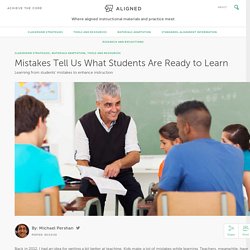
Kids make a lot of mistakes while learning. Teachers, meanwhile, have to quickly respond to those mistakes. What if I could prepare for those moments outside of the classroom? I need some help (groupthink). What do the eight effective mathematics teaching practices look like for online teaching? What are the promises and challenges? I appreciate any and all thoughts. Thanks!… If you are a math or science teacher educator and have used our teaching channel videos, here's a file with some links where you can continue to access them for free. #mtbos #iteachmath. How Kobe Bryant challenged me to be a better math teacher. - Sara VanDerWerf. Hello friends!
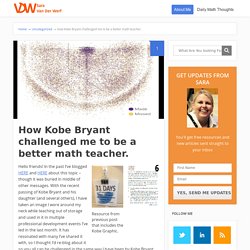
In the past I’ve blogged HERE and HERE about this topic – though it was buried in middle of other messages. With the recent passing of Kobe Bryant and his daughter (and several others), I have taken an image I wore around my neck while teaching out of storage and used in it in multiple professional development events I’ve led in the last month. It has resonated with many I’ve shared it with, so I thought I’d re-blog about it so you all can be challenged in the same way I have been by Kobe Bryant and a graphic representing his NBA career. Feel free to watch this short video explaining this OR read below the video link for more.
In 2016, I found the following graphic from an article on the cover of the LA Times the day Kobe Bryant retired. 5 Questions to Ask Yourself About Your Unmotivated Students. How can we help teachers overcome their fear of teaching math in a new way? Response: Classrooms Don't Need 'Pinterest-y Looking Walls' (This is the final post in a three-part series.
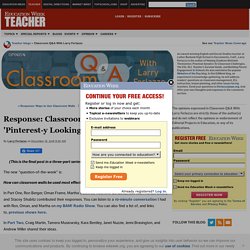
You can see Part One here and Part Two here.) The new "question-of-the-week" is: How to Talk Less to Improve Learning. Start With Struggle Jo Boaler, a revolutionary researcher and math educator, says that struggle is critical to mastering a skill or concept.
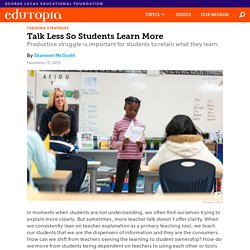
When we sense discomfort in our classrooms, we can be quick to explain and provide steps to follow. But removing the struggle for students also removes the cognitive heavy lifting that leads to deep learning and understanding. Shift the script and begin lessons by asking students to experience struggle. Explain what you are doing and how grappling with concepts will help them learn before support is given. In other subjects, use brain research to encourage students to persevere through writer’s block or try a task for a second or third time. What are your student engagement strategies? Your answer matters.… Strategies to #shiftthelift in Mathematics @achievethecore… Classroom Norms - for students & TEACHERS. - Sara VanDerWerf. This GIF will give away my age.
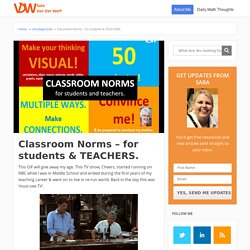
This TV show, Cheers, started running on NBC while I was in Middle School and ended during the first years of my teaching career & went on to live in re-run world. Back in the day this was ‘must-see TV’. On the show ‘Cheers’, every time one of the main characters walked into the bar at the center of the show, the patrons of the bar would yell his name ‘NORM!’.
(the theme song included the lyrics ‘where everyone knows your name’). The bartender Sam would then ask Norm, “What are you up to, Norm? Embedding the CCSS Mathematical Practices into Math Instruction. The Common Core State Standards for Math actually include two types of standards: the content standards and the standards for mathematical practice.

The content standards define the specific skills that are to be mastered at each grade level. For example, multiplication, division, and fractions are all content standards for 3rd grade. The standards for mathematical practice, however, outline how students go about doing the math. They are skills, based on the NCTM process standards, which students should utilize on a daily basis, regardless of the content being taught. Simple Ways to Integrate Four Evidence-Based Teaching Strategies. When educators understand the science behind teaching practices they can more readily incorporate them into their daily instruction, says Cult of Pedagogy’s Jennifer Gonzalez.
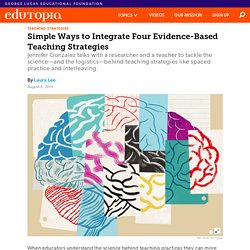
In her podcast and accompanying post, Gonzalez highlights the four key teaching strategies researcher that Pooja Agarwal and K–12 teacher Patrice Bain feature in their new book, Powerful Teaching: Unleash the Science of Learning. They explain the science behind the suggestions, many of which are familiar, as well as best practices and applications for each one. Retrieval practice: The goal is for students to recall information from memory and reinforce learning through quick daily assessments.
Evidence shows that actively accessing learned material—rather than merely reteaching it—boosts retention. Beyond the Lesson Discussion Guide Mathematics. Using Play to Teach Math. The concept of play is often limited to younger students and less academic endeavors, but play can be a useful strategy in an unlikely discipline: math. Mathematics is known as cold, logical, and rigorous, but the subject doesn’t get enough credit for its true mischievous spirit, which is well-hidden from the world. The K–12 mathematics curricula can involve time and space to play with concepts and ideas, even in the rush of required topics.
In my research for a 2017 talk I gave at TEDxKitchenerEd called “Math Is Play,” I found few materials on the joy of math in upper grades. Much of the literature on play as a learning approach is based on the early years, particularly kindergarten, where it is an accepted pedagogical mode. Young children at play often reach a state that psychologist Mihaly Csikszentmihalyi calls “flow,” an elusive state of mind where time seems to disappear as they focus deeply on what they’re doing. Empower Students Through Individual Conferences. Learning to Listen and Listening to Learn — zacharychampagne.com. And with these two inputs, I became fascinated with the power of not talking so much. 0210 Ed Leadership. Never Skip the Closing of the Lesson. Once again, Tracy Zager has pushed us to think about our teaching.
In her recent talk at #TMC16 Tracy asked us to consider what it means to “close the lesson”. Here is an example of a problem and a potential close, followed by some of my thoughts about how we should close any lesson. First of all, give a problem that will help you achieve a specific goal. Take this problem published in Marilyn Burn’s 50 Problem Solving Lessons resource: If rounds 1 & 2 of a tug-of-war contest are a draw, who will win the final round? Here is the full problem. Once students understand the problem and are given time to write their solution (individually or in pairs) the learning isn’t over. Closing the lesson: Tips for Teachers: Critical ingredients for a successful mathematics lesson. What are the ingredients for an effective mathematics lesson? Teachers are continually faced with a range of advice or ideas to improve their mathematics lessons and often this just creates confusion. It’s a little bit like being a cook.
New recipes appear online and in cookbooks on bookstore shelves, but often they’re just adaptations of classic recipes that have been around before, their foundation ingredients are tried and tested, and often evidence based. There are always the staple ingredients and methods that are required for the meal to be successful. The following is a list of what I consider to be important ingredients when planning and teaching an effective mathematics lesson. The Best Math Practices For Teachers. Instructional Practice Toolkit and Classroom Videos - Supplemental Lesson Videos. Inviting Participation With Thumbs-Up Responses. Robertkaplinsky. Robertkaplinsky. "Student-Centered" vs "Traditional" Math Teaching.
I’d like to reframe the divide that seems to exist when we talk about “student-centered teaching” and “traditional teaching.” Instead, I suggest that we use these labels to describe, without blanket judgment, two different kinds of teaching decisions, each with its own purpose and value. Limiting “Teacher Talk,” Increasing Student Work! “Wah waah wah waah wah wah…” We all know the famous muted trumpet of adults in Charlie Brown’s world, especially their teacher, Miss Othmar. 11 Strategies in Teaching Mathematics. Count It All Joy. Why Kids Need More Talk Time in the Classroom. Sometimes, for the sake of classroom management, we spend so much time trying to manage noise level that we forget that talk time in the classroom is actually an important element of learning. In fact it’s really important. 10 Fun Alternatives to Think-Pair-Share.
All learners need time to process new ideas and information. They especially need time to verbally make sense of and articulate their learning with a community of learners who are also engaged in the same experience and journey. What Will They Be Doing? Anchor Charts 101: Why and How to Use Them, Plus 100s of Ideas. Spend any time browsing teacher pages on Pinterest and Instagram, and you’ll run across hundreds of ideas for classroom anchor charts. But you may have lingering questions about what they are, what purpose they serve, how to get started, and when to use them. Have no fear! WeAreTeachers has created this primer to inform you, and we’ve also included a huge list of resources to get you started.
We have a feeling that once you get started, anchor charts are going to your new favorite thing. How to Use Anchor Charts in Your Classroom. You see them all over Pinterest. Becoming the Math Teacher You Wish You'd Had. My girls started school yesterday. Robertkaplinsky. Two Common Misconceptions About Learning. It's another semester with a new group of students. This semester, I have a class of elementary education majors (using Physics and Everyday Thinking). In the course, students build basic physics ideas after collecting data from particular experiments.
Overall, this is an awesome course. Building A Culturally Responsive Classroom. MobilePagedReplica. 5 principles of extraordinary math teaching. Nine “Look Fors” in the Elementary Math Classroom. Questioning and Vocabulary Supports That Inspire Language-Rich Mathematics. Nctm. Demonstrating Conceptual Understanding of Mathematics Using Technology. How to Become and Remain a Transformational Teacher. Just-in-Time vs. Just-in-Case Scaffolding: How to Foster Productive Perseverance.
Classroom Clock: Andrew Stadel. NCTM 2018 Resources for Attendees. Research-Based Education Strategies & Methods. Making Math Visual. [NCTM18] Why Good Activities Go Bad. Nctm. Strategies vs Models. Rebranding "Show Your Work" Nine “Look Fors” in the Elementary Math Classroom. Robertkaplinsky. Mathematical Habits of Mind. How the 5 Practices Changed my Instruction – Illustrative Mathematics.
Starting where our students are….. with THEIR thoughts. The Importance of Debriefing in Learning and What That Might Look Like in the Classroom. Instructional Strategies List for Teachers - Instructional Strategies List. Teaching for Understanding. Targeted Instruction. 8 Teaching Habits that Block Productive Struggle in Math Students. Levels of Classroom Discourse. Edutopia. Outlaw "I'm Done!" – Teacher Trap. Hands-Off Teaching Cultivates Metacognition. Navigating Success for All Students Begins with a Map.
Edutopia. 12 Curriculum Planning Tips For Any Grade Level Or Content Area. #ObserveMe. 14 Resources on Crafting Learning Objectives. 22 Powerful Closure Activities. How to change everything and nothing at the same time! – Thinking Mathematically. Great Minds, Great Conversations. Create & Find Multimedia Lessons in Minutes. Supporting Sense Making with Mathematical Bet Lines. Visual Reasoning Tools in Action. One Way I Get Students To Persevere – Robert Kaplinsky. Education Week.